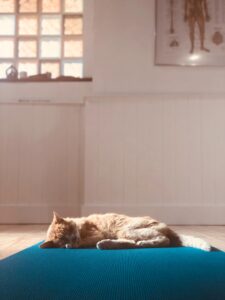Prepositions serve a similar function to conjunctions: they connect other parts of speech together. But while conjunctions connect clauses, or groups of words containing a noun and related verb, prepositions connect nouns (or pronouns) with other nouns (or pronouns). In addition, this connection is usually one that relates to space or time. (There is hint in the name pre/position, if you think of pre being a term that can relate to time, while position is a word that relates to space.)
- The cat on the mat is asleep. (The cat is connected in space to the mat by the preposition on)
- I like to have a bath after a tiring day. (A bath is connected in time to a tiring day by the preposition after)

The cat on the mat is asleep
If we think of nouns as being like shipping containers, prepositions are like the special cranes that arrange them neatly in useful and meaningful ways.

A random group of nouns (containers) are connected by prepositions (a crane) in time and space to arrange them in a more meaningful way.
Prepositions can enable us to connect several nouns in a string.
- This is my gift to you with all of my love for Valentine’s Day.
The prepositions to, with, of and for connect the noun gift to the pronoun you to the pronoun all to the noun love to the noun Valentine’s Day.

This is my gift to you with all of my love for Valentine’s Day: prepositions connect nouns and pronouns in a meaningful string
Prepositions are also used to change the meaning of verbs, but this is not usually described as their function (and they are sometimes as being adverbs when they are used for this purpose).
Prepositions are sometimes described as ‘short words’, and while many of them are short – in, of, at, to, on, by, out, for, over, with – others are not: between, through. It is more helpful to remember their function. There are about 150 prepositions in English and we won’t be getting any more. The language is not developing new prepositions, unlike nouns and verbs.
If you know the children’s skipping chant, ‘In, out, over, under’, to which children move in time and space, it may help you remember what prepositions are and what they do, as all the words in the chant are prepositions.

A children’s skipping chant can help you remember what prepositions are and what they do

If you have found this post interesting, you can find a full index to my other posts on the index page. To be notified when I post a new topic, follow me on Facebook! If you have any particular questions you’d like me to answer in future posts, just send me a message. I’m always interested to learn what people think, and how you came across this site, so please post a comment.
If you think you would be interested in either my complete grammar course or an individual customised online course (particularly suited for people who don’t live in Melbourne), just click your preferred option.